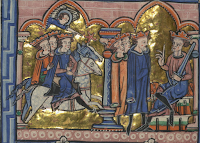and so we have arrived at the end of the Journey of the Magi, and today we have the Feast of Epiphany.
For this occasion I selected this illumination from an East Anglian codex titled Carrow Psalter presently held at the Walters Art Museum in Baltimore, USA.
It was created during the mid-century and is very important in many ways, including the depiction showing the murder and martyrdom of Saint Thomas Becket by 4 knights (with their retainers) of king Henry II of England inside the Canterbury Cathedral.
The Magi are shown riding at the flying gallop (?), or with the front and hind horses' legs extended as in a jump, a traditional way to show fastest gait of the horse before the XIX century. They are following the Bethlehem Star with their gifts shown a bit in right hand, while guiding their mounts with the left, or at lest the two Magi are doing this.
The mounts are presumably stallions as their sex is shown, and again are grey, just the middle one is shown to be a steel grey for the sake of contrast I presume.
The monk painting this illumination created flying tails which is perhaps another indication of the fast speed.
Horses have multicolored tack, their bridles have no curb-bit but what appear to be a snaffle and a single set of reins. Perhaps they are riding in full collection, as their heads are elevated etc. The bridle has no throatlatch but a browband.
The saddle of the front Magi has black color covering the saddle skirts and shabraque or just longish skirts, extending and tapering to the back, and light brown high arches, typical of the period saddles.
Whether the saddle skirts were in fact this long or painted & dyed black, or dyed some other color we will not know, but the single cinch is also typical, note its width and the criss-cross pattern on it most likely indicating that it was made out of woven fabric.
 |
| Matthew of Paris pinxit - war saddle of the period, note the breastcollar arrangement in relationship to the saddle, also the cinch buckle |
 |
| Matthew of Paris, saddle with larger skirts, underneath rectangular shabraque |
 |
| Matthew of Paris, a saddle with short saddle skirts, but large textile shabraque edged with loose fringe |
 |
| the second half of XIIIc, saddle with either saddle skirts or a saddle shabraque |
 |
| Magi riding and then visiting Herod the Great |
Adoration of the Magi - detail from the illumination
Valete!

4 comments:
Epiphany in Poland
https://twitter.com/TKaczowka/status/949593300985696256/photo/1
https://twitter.com/ArchKrakowska/status/949595477166755840/video/1
https://twitter.com/EpiskopatNews/status/949606610741153793/photo/1
https://twitter.com/FelicjanDulski/status/949605675335864320/photo/1
https://twitter.com/wojciechnaja/status/949606880770445312/photo/1
Procession in the ancient capital of Poland - Krakow - http://blogpress.pl/node/24689
Three Kings Procession in Lowicz, the ancient seat of the Archbishops of the Crown ruined by the Swedes during the Deluge (Potop)- https://www.youtube.com/watch?v=56PM_5214rs
http://www.lowiczturystyczny.eu/Dla-turystow-Ziemia-Lowicka,36
Krzesimir Dębski - Polonez Husarii - https://www.youtube.com/watch?v=SaDwCjWi3OE
https://gloria.tv/video/JeJJyCjnno4e6XmeG8rQWqEjJ - Czestochowa
Post a Comment